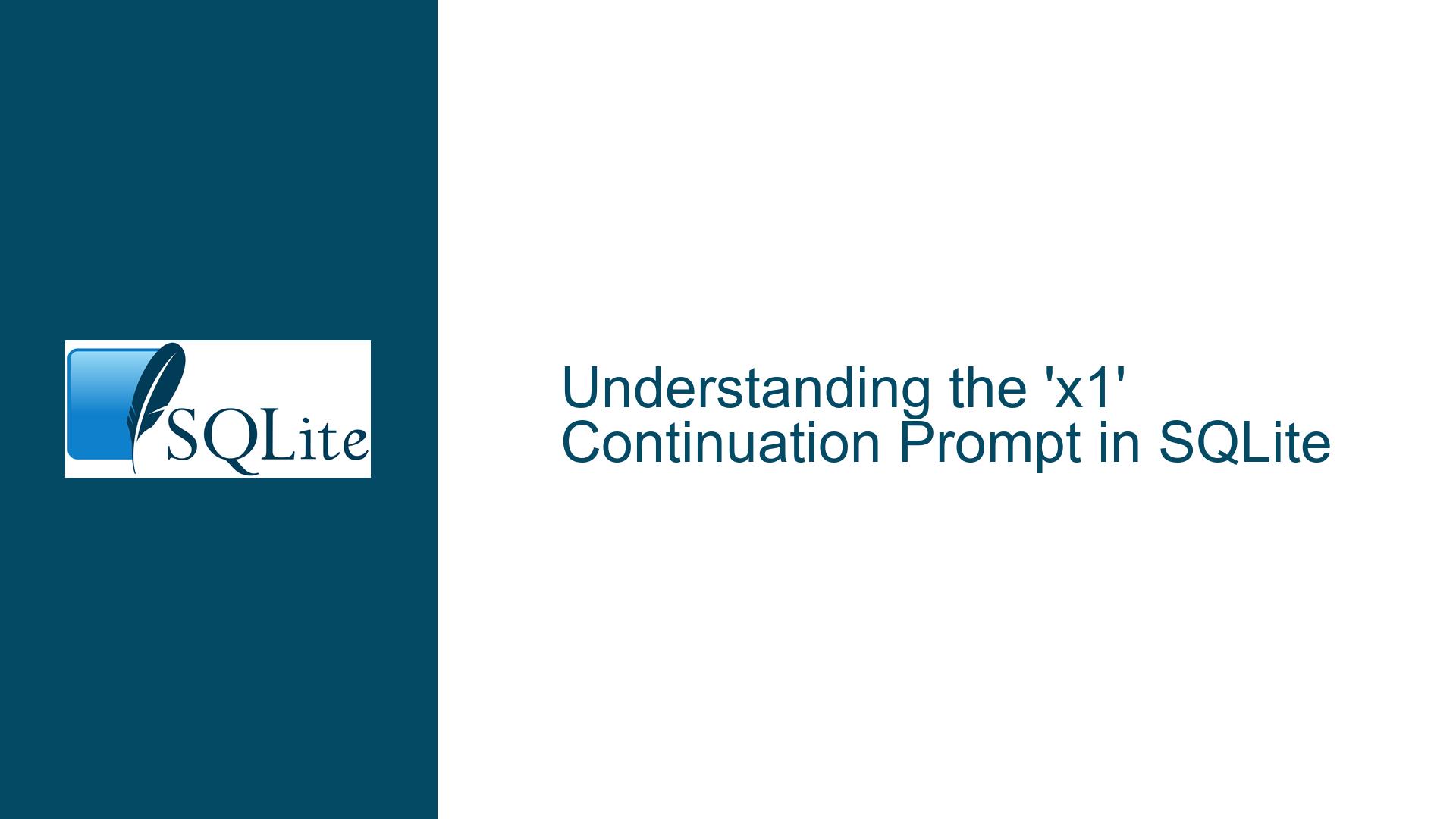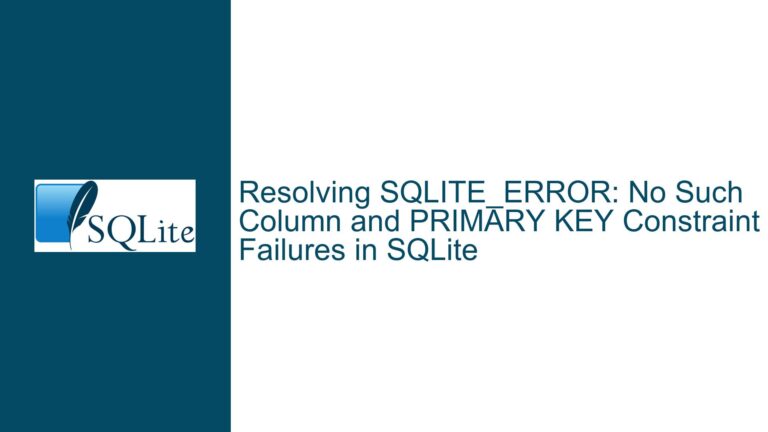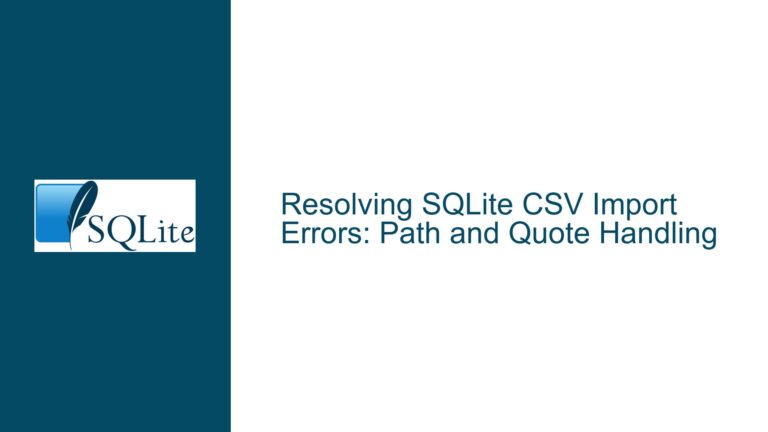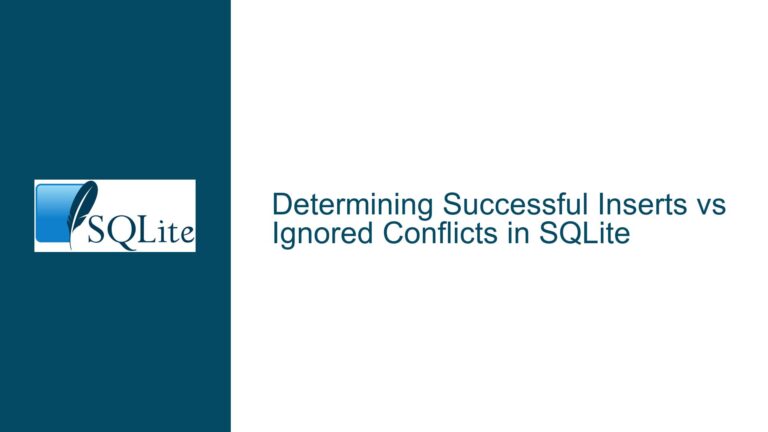the ‘x1’ Continuation Prompt in SQLite
Explanation of the ‘x1’ Continuation Prompt in SQLite
In SQLite, when a command is entered into the command-line interface (CLI) and is not completed, the system provides a continuation prompt to indicate that more input is expected. The prompt typically appears as ...> after the initial command prompt (sqlite>). However, users may encounter variations in this continuation prompt that can lead to confusion, such as the appearance of x1 in place of the standard continuation prompt.
The occurrence of x1 in the SQLite prompt signifies that there is an open parenthesis that needs to be matched or resolved. This behavior is tied to how SQLite interprets parentheses within SQL commands. When a user initiates a command that includes an opening parenthesis, SQLite tracks these parentheses to ensure they are balanced. Each level of unclosed parentheses increases the number shown in the continuation prompt. Thus, if there is one unclosed parenthesis, the continuation prompt will display x1, indicating that there is one level of parentheses to resolve.
This can be illustrated with an example. Consider the following SQL command:
sqlite> create table table1
...> (
(x1> c1,
(x1> c2,
(x1> c3
(x1> );
In this instance, the user has begun creating a table but has not closed the opening parenthesis properly. As a result, SQLite responds with x1, indicating that there is one unmatched opening parenthesis. If additional opening parentheses were added without corresponding closing ones, the number would increase accordingly (e.g., x2 for two unmatched parentheses).
Understanding this behavior is crucial for anyone working with SQLite, as it helps prevent syntax errors and ensures that SQL commands are properly formatted before execution. Users should always ensure that for every opening parenthesis there is a corresponding closing parenthesis to avoid confusion and potential errors during database operations.
The confusion surrounding this prompt often arises from users who are accustomed to different behaviors in other programming languages or database systems. For example, some environments may not display such prompts or may use different indicators for continuation. Therefore, recognizing how SQLite handles these cases is essential for effective database management and query execution.
Additionally, users may find it helpful to refer to official documentation or community forums when encountering unexpected behavior in SQLite. The official SQLite CLI documentation provides insights into various aspects of command-line usage, including how prompts function and what they signify. Familiarizing oneself with these details can greatly enhance a developer’s efficiency and accuracy when working with SQLite databases.
In conclusion, the x1 continuation prompt in SQLite serves as a helpful indicator for users to identify unclosed parentheses within their SQL commands. By ensuring proper matching of parentheses and understanding how SQLite interprets these structures, developers can avoid common pitfalls and streamline their database interactions.
Common Causes for the ‘x1’ Continuation Prompt in SQLite
The occurrence of the x1 continuation prompt in SQLite can be attributed to several common issues that arise when users interact with the SQLite command-line interface (CLI). Understanding these causes is essential for diagnosing and resolving problems effectively.
Unmatched Parentheses
One of the primary reasons for encountering the x1 prompt is unmatched parentheses in SQL commands. SQLite uses a continuation prompt to indicate that an SQL statement is incomplete, particularly when parentheses are involved. When a user begins a command with an opening parenthesis but fails to provide a corresponding closing parenthesis, SQLite will display x1, indicating that there is one unmatched parenthesis. This behavior is consistent across various SQL commands, including CREATE TABLE, SELECT, and others that utilize parentheses for defining structures or conditions.
For example, consider the following SQL command:
sqlite> CREATE TABLE example (
...> column1 INTEGER,
...> column2 TEXT,
...> column3 REAL
...> ( -- Missing closing parenthesis
In this case, the user has opened a parenthesis without closing it, prompting SQLite to display x1. To resolve this issue, users must ensure that every opening parenthesis has a corresponding closing parenthesis.
Missing Semicolons
Another frequent cause of the x1 continuation prompt is the omission of semicolons at the end of SQL statements. In SQLite, each SQL command must be terminated with a semicolon (;) to indicate that the command is complete. If a semicolon is missing, SQLite will interpret this as an indication that more input is required, resulting in the continuation prompt.
For instance:
sqlite> SELECT * FROM users -- Missing semicolon
...>
In this scenario, because the semicolon is absent, SQLite continues to wait for further input. Users should always remember to include a semicolon at the end of each SQL statement to avoid this prompt.
Incomplete String Literals
Incomplete string literals can also lead to the x1 continuation prompt. If users begin a string with either single (') or double (") quotes but fail to close it properly, SQLite will not recognize the command as complete. This situation often occurs when users forget to close their quotes or accidentally press Enter before completing their input.
For example:
sqlite> INSERT INTO products (name) VALUES ('Gadget -- Unclosed string literal
...>
Here, the missing closing quote for the string literal results in SQLite displaying x1. To fix this issue, users must ensure that all string literals are properly enclosed within matching quotes.
Incorrect Dot Commands
SQLite’s CLI also recognizes dot commands (commands starting with a period) for various operations. If users incorrectly enter these commands or forget to complete them properly, they may inadvertently trigger the continuation prompt. For instance:
sqlite> .table -- Incomplete dot command
...>
In this case, since .table is not followed by any additional parameters or completed with a semicolon, SQLite waits for further input. Users should familiarize themselves with valid dot commands and ensure they are used correctly.
Conclusion
Understanding the common causes of the x1 continuation prompt in SQLite can significantly enhance user experience and efficiency when working with the CLI. By ensuring that parentheses are matched correctly, semicolons are included at the end of statements, string literals are closed properly, and dot commands are used correctly, users can avoid unnecessary confusion and streamline their database interactions. Recognizing these issues early on will lead to smoother database management and query execution in SQLite.
Steps to Resolve the ‘x1’ Continuation Prompt in SQLite
To effectively address the occurrence of the x1 continuation prompt in SQLite, users can follow a series of troubleshooting steps and solutions designed to correct common issues associated with SQL command input. These steps focus on ensuring that SQL statements are properly formatted and complete before execution.
Verify Parentheses Matching
The first step in resolving the x1 continuation prompt is to carefully check for unmatched parentheses in SQL commands. Users should ensure that every opening parenthesis has a corresponding closing parenthesis. This can be done manually by reviewing the SQL statement or using text editors with syntax highlighting that can visually indicate unmatched parentheses.
For example, consider the following SQL command:
CREATE TABLE example (
column1 INTEGER,
column2 TEXT,
column3 REAL
In this case, the command is missing a closing parenthesis. To correct it, simply add the closing parenthesis:
CREATE TABLE example (
column1 INTEGER,
column2 TEXT,
column3 REAL
);
Users may also utilize regular expressions or text editor features to search for unmatched parentheses within their SQL scripts, which can expedite the debugging process.
Ensure Proper Command Termination
Another critical aspect to check is whether each SQL command is properly terminated with a semicolon (;). Omitting the semicolon will cause SQLite to interpret the command as incomplete, leading to the continuation prompt.
For instance, a command like this:
SELECT * FROM users
should be modified to include a semicolon:
SELECT * FROM users;
It is essential for users to develop a habit of always concluding their SQL statements with a semicolon, particularly when working in environments like SQLite where this is required for command completion.
Close String Literals Appropriately
When working with string literals in SQL commands, users must ensure that all quotes are properly closed. An unclosed string literal will prevent SQLite from recognizing the command as complete and will result in the continuation prompt being displayed.
For example:
INSERT INTO products (name) VALUES ('Gadget
should be corrected by adding the closing quote:
INSERT INTO products (name) VALUES ('Gadget');
By maintaining proper quotation practices and ensuring that all string literals are complete, users can avoid unnecessary interruptions while executing commands.
Validate Dot Commands
SQLite’s CLI includes dot commands (commands starting with a period) that serve various functions. If these commands are not completed correctly or are used improperly, they may trigger the continuation prompt. Users should familiarize themselves with valid dot commands and ensure they are executed correctly.
For instance, a valid dot command might look like this:
.tables;
If a user types .tables without a semicolon or additional parameters when required, they may encounter the continuation prompt. Always verify that dot commands are entered correctly and completed with necessary punctuation.
Utilize Command-Line Options Effectively
When launching SQLite from the command line, it is important to ensure that users are entering commands correctly and not inadvertently causing issues. For instance, running SQLite without specifying a database file can lead to unexpected behavior.
To open a specific database file directly from the command line, use:
sqlite3 mydatabase.db
This ensures that SQLite operates on the intended database file rather than defaulting to an in-memory database.
Conclusion
By following these troubleshooting steps—verifying parentheses matching, ensuring proper command termination with semicolons, closing string literals appropriately, validating dot commands, and utilizing command-line options effectively—users can resolve issues related to the x1 continuation prompt in SQLite. Developing these habits will enhance overall efficiency and reduce frustration when interacting with SQLite’s CLI environment.






